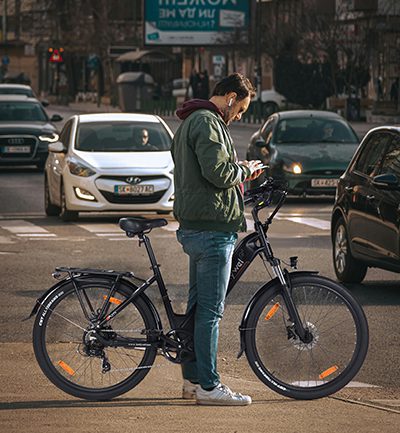Electric bikes, or e-bikes, have come a long way since their inception. What started as a niche product for tech enthusiasts has now become a mainstream mode of transportation, thanks to continuous advancements in technology and design. As the demand for sustainable and efficient mobility solutions grows, manufacturers are pushing the boundaries of innovation to deliver e-bikes that are smarter, faster, and more user-friendly than ever before. In this blog post, we’ll explore some of the most exciting cutting-edge features in the world of e-bikes that you simply can’t afford to miss.
Smart Connectivity and App Integration
Gone are the days when an e-bike was just a bike with a motor. Today’s e-bikes are equipped with smart features that integrate seamlessly with your smartphone. Many models now come with dedicated apps that allow riders to track their routes, monitor battery life, adjust motor settings, and even lock or unlock their bikes remotely. Some apps also offer navigation, fitness tracking, and ride-sharing capabilities, turning your e-bike into a fully connected mobility device.
For example, brands like VanMoof and Specialized have introduced e-bikes with built-in GPS and anti-theft systems, ensuring your bike is always secure and traceable.
Lightweight and High-Performance Batteries
One of the biggest challenges for e-bike manufacturers has been balancing battery life with weight. However, recent innovations in battery technology have led to the development of lightweight, high-capacity batteries that can deliver impressive ranges. Lithium-ion batteries remain the standard, but new materials like solid-state batteries are on the horizon, promising even greater energy density and faster charging times.
Some e-bikes now feature removable batteries that can be charged on or off the bike, making it convenient for riders who don’t have easy access to power outlets.
Regenerative Braking Systems
Inspired by electric cars, regenerative braking is making its way into the e-bike world. This feature allows the bike to recover energy during braking and feed it back into the battery, extending the overall range. While not yet widespread, regenerative braking is a game-changer for eco-conscious riders looking to maximize efficiency.
Advanced Motor Systems
The heart of any e-bike is its motor, and recent advancements have made motors more powerful, compact, and quiet. Mid-drive motors, which are positioned near the bike’s crankshaft, have become increasingly popular due to their balanced weight distribution and natural riding feel. Additionally, torque sensors have replaced cadence sensors in many high-end models, providing smoother and more responsive power delivery based on how hard you pedal.
Brands like Bosch and Shimano are leading the charge with motors that offer up to 85 Nm of torque, making uphill climbs and long-distance rides a breeze.
Adaptive Assist and AI-Powered Riding
Artificial intelligence is finding its way into e-bikes, enabling features like adaptive assist. This technology adjusts the level of motor assistance based on factors like terrain, rider input, and even heart rate. For instance, if you’re climbing a steep hill, the bike will automatically increase power to make the ascent easier. Similarly, on flat terrain, it might reduce assistance to conserve battery.
Some e-bikes are also experimenting with AI-powered route optimization, suggesting the most efficient paths based on traffic, weather, and road conditions.
Sleek and Stylish Designs
e-bikes are no longer clunky eyesores. Modern designs prioritize aesthetics without compromising functionality. From minimalist frames to hidden cables and integrated batteries, today’s e-bikes are as stylish as they are practical. Folding e-bikes, in particular, have gained popularity for their portability and space-saving design, making them ideal for urban commuters.
Enhanced Safety Features
Safety is a top priority for e-bike manufacturers, and new models are packed with features to keep riders secure. These include advanced LED lighting systems for better visibility, automatic brake lights, and even turn signals. Some e-bikes also come with collision detection and emergency braking systems, similar to those found in cars.
Customizable Riding Modes
Whether you’re looking for a workout or a leisurely ride, modern e-bikes offer customizable riding modes to suit your needs. Eco mode conserves battery for long distances, Sport mode delivers maximum power for high-speed rides, and Touring mode strikes a balance between the two. Some models even allow you to create and save your own custom modes.
Suspension and Comfort Innovations
For off-road enthusiasts, full-suspension e-bikes with advanced shock absorbers are becoming more common. These bikes are designed to handle rough terrains while providing a smooth and comfortable ride. Additionally, ergonomic saddles, adjustable handlebars, and vibration-dampening frames are now standard in many models.
Sustainability and Eco-Friendly Materials
As the world becomes more environmentally conscious, e-bike manufacturers are exploring sustainable materials and production methods. From recycled aluminum frames to biodegradable components, the industry is taking steps to reduce its carbon footprint. Some companies are even offering buy-back programs to recycle old batteries and components.
Conclusion
The e-bike revolution is in full swing, and the innovations we’re seeing today are just the beginning. With smarter technology, improved performance, and a focus on sustainability, e-bikes are poised to become the future of urban and recreational mobility. Whether you’re a daily commuter, an adventure seeker, or someone looking to reduce their environmental impact, there’s an e-bike out there with cutting-edge features tailored to your needs.
So, what are you waiting for? It’s time to hop on the e-bike bandwagon and experience the future of cycling firsthand!


